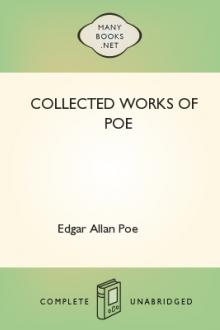The Works of Edgar Allan Poe — Volume 2, Edgar Allan Poe [read more books .txt] 📗

- Author: Edgar Allan Poe
Book online «The Works of Edgar Allan Poe — Volume 2, Edgar Allan Poe [read more books .txt] 📗». Author Edgar Allan Poe
(*6) In the year 1790, in the Caraccas during an earthquake a portion of the granite soil sank and left a lake eight hundred yards in diameter, and from eighty to a hundred feet deep. It was a part of the forest of Aripao which sank, and the trees remained green for several months under the water.”—Murray, p. 221
(*7) The hardest steel ever manufactured may, under the action of a blowpipe, be reduced to an impalpable powder, which will float readily in the atmospheric air.
(*8) The region of the Niger. See Simmona’s Colonial Magazine.
(*9) The Myrmeleon—lion-ant. The term “monster” is equally applicable to small abnormal things and to great, while such epithets as “vast” are merely comparative. The cavern of the myrmeleon is vast in comparison with the hole of the common red ant. A grain of silex is also a “rock.”
(*10) The Epidendron, Flos Aeris, of the family of the Orchideae, grows with merely the surface of its roots attached to a tree or other object, from which it derives no nutriment—subsisting altogether upon air.
(*11) The Parasites, such as the wonderful Rafflesia Arnaldii.
(*12) Schouw advocates a class of plants that grow upon living animals—the Plantae Epizoae. Of this class are the Fuci and Algae.
Mr. J. B. Williams, of Salem, Mass., presented the “National Institute” with an insect from New Zealand, with the following description: “‘The Hotte, a decided caterpillar, or worm, is found gnawing at the root of the Rota tree, with a plant growing out of its head. This most peculiar and extraordinary insect travels up both the Rota and Ferriri trees, and entering into the top, eats its way, perforating the trunk of the trees until it reaches the root, and dies, or remains dormant, and the plant propagates out of its head; the body remains perfect and entire, of a harder substance than when alive. From this insect the natives make a coloring for tattooing.
(*13) In mines and natural caves we find a species of cryptogamous fungus that emits an intense phosphorescence.
(*14) The orchis, scabius and valisneria.
(*15) The corolla of this flower (Aristolochia Clematitis), which is tubular, but terminating upwards in a ligulate limb, is inflated into a globular figure at the base. The tubular part is internally beset with stiff hairs, pointing downwards. The globular part contains the pistil, which consists merely of a germen and stigma, together with the surrounding stamens. But the stamens, being shorter than the germen, cannot discharge the pollen so as to throw it upon the stigma, as the flower stands always upright till after impregnation. And hence, without some additional and peculiar aid, the pollen must necessarily fan down to the bottom of the flower. Now, the aid that nature has furnished in this case, is that of the Tiputa Pennicornis, a small insect, which entering the tube of the corrolla in quest of honey, descends to the bottom, and rummages about till it becomes quite covered with pollen; but not being able to force its way out again, owing to the downward position of the hairs, which converge to a point like the wires of a mouse-trap, and being somewhat impatient of its confinement it brushes backwards and forwards, trying every corner, till, after repeatedly traversing the stigma, it covers it with pollen sufficient for its impregnation, in consequence of which the flower soon begins to droop, and the hairs to shrink to the sides of the tube, effecting an easy passage for the escape of the insect.”—Rev. P. Keith-System of Physiological Botany.
(*16) The bees—ever since bees were—have been constructing their cells with just such sides, in just such number, and at just such inclinations, as it has been demonstrated (in a problem involving the profoundest mathematical principles) are the very sides, in the very number, and at the very angles, which will afford the creatures the most room that is compatible with the greatest stability of structure.
During the latter part of the last century, the question arose among mathematicians—“to determine the best form that can be given to the sails of a windmill, according to their varying distances from the revolving vanes, and likewise from the centres of the revolution.” This is an excessively complex problem, for it is, in other words, to find the best possible position at an infinity of varied distances and at an infinity of points on the arm. There were a thousand futile attempts to answer the query on the part of the most illustrious mathematicians, and when at length, an undeniable solution was discovered, men found that the wings of a bird had given it with absolute precision ever since the first bird had traversed the air.
(*17) He observed a flock of pigeons passing betwixt Frankfort and the Indian territory, one mile at least in breadth; it took up four hours in passing, which, at the rate of one mile per minute, gives a length of 240 miles; and, supposing three pigeons to each square yard, gives 2,230,272,000 Pigeons.—“Travels in Canada and the United States,” by Lieut. F. Hall.
(*18) The earth is upheld by a cow of a blue color, having horns four hundred in number.”—Sale’s Koran.
(*19) “The Entozoa, or intestinal worms, have repeatedly been observed in the muscles, and in the cerebral substance of men.”—See Wyatt’s Physiology, p. 143.
(*20) On the Great Western Railway, between London and Exeter, a speed of 71 miles per hour has been attained. A train weighing 90 tons was whirled from Paddington to Didcot (53 miles) in 51 minutes.
(*21) The Eccalobeion
(*22) Mäelzel’s Automaton Chess-player.
(*23) Babbage’s Calculating Machine.
(*24) Chabert, and since him, a hundred others.
(*25) The Electrotype.
(*26) Wollaston made of platinum for the field of views in a telescope a wire one eighteen-thousandth part of an inch in thickness. It could be seen only by means of the microscope.
(*27) Newton demonstrated that the retina beneath the influence of the violet ray of the spectrum, vibrated 900,000,000 of times in a second.
(*28) Voltaic pile.
(*29) The Electro Telegraph Printing Apparatus.
(*30) The Electro telegraph transmits intelligence instantaneously—at least at so far as regards any distance upon the earth.
(*31) Common experiments in Natural Philosophy. If two red rays from two luminous points be admitted into a dark chamber so as to fall on a white surface, and differ in their length by 0.0000258 of an inch, their intensity is doubled. So also if the difference in length be any whole-number multiple of that fraction. A multiple by 2 1/4, 3 1/4, &c., gives an intensity equal to one ray only; but a multiple by 2 1/2, 3 1/2, &c.,





Comments (0)